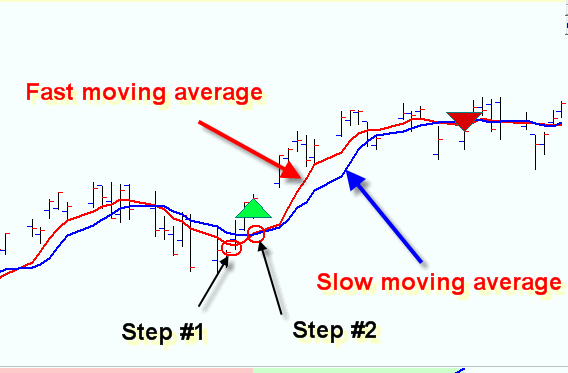
Trend following systems - "Lost Paradise"
written by Sergey Tarassov
Imagine that you have found a time machine that is able to deliver you to 1900s. Plus it takes you there with all your computers, programs, modern knowledge, etc. Would you trade then successfully? I think yes.
Though the stock market a hundred years ago was as challenging as always, it had had some big advantage compared to the stock market of today. This advantage was a possibility to apply the trend following system. In this article I will try to compare DJI now and then, and you will see how significant is the difference between trading the trend following market and that one that we have today.
Classical moving averages crossover - a trend following system
A classical moving averages crossover trading system looks like this:

Here the program generates a buy signal when the fast (red) moving average crosses the slow moving average (blue) from down to up; vise versa a sell signal is generated on up to down crossover. The logic of this trading system is pretty obvious, it consists of two steps:
Step #1 - watch the moment when the fast moving average reaches its bottom;
Step #2 - wait some time while this up trend movement is confirmed by up movement; the crossover with the slow moving average employs this procedure
This strategy is pretty obvious and intuitively very clear. The main figure here is the trend, and our goal here is to reveal the moment when this trend begins. Thus it is a trend following system.
Inverted moving averages crossover - return to average system
We may apply another rule - buying when the fast moving average crosses the slow moving average FROM UP TO DOWN. If we do that, we get a totally different trading system.
This is how an inverted system looks:
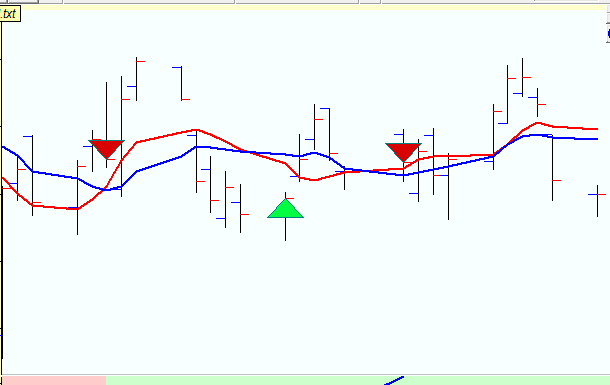
Here the price movement appears more like an oscillation around the slow (blue) moving average. If the price moves too far from the blue curve, it returns back to some average value. The main figure here is the tendency of the price to return to that average value.
Compared to the first example where the slow (blue) moving average gives the "green light" for a further trending movement, the slow moving average in the second example provides the attraction level, and the price oscillates around this level.
Thus we can specify two styles of the price movement - trend following and return to average. I would like to mention that these two behavior patterns are not related directly to the trending and sideway market. If the trend is strong, we may have more trend following patterns, but it is not always so. For example, within a period of the strong up trend movement in the year 2003 - the beginning of 2004, we still had many return to average movements:
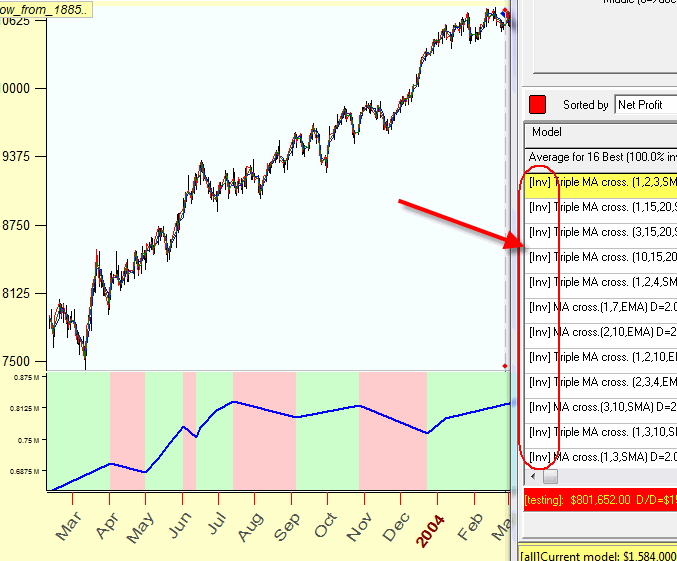
This issue is more than just trend. In Chaos theory, two kinds of systems are defined: persistent and anti persistent systems. These two types of market behavior (described above) correspond to this definition. Below I will try to explain these entities conducting a research and using the language understandable by a trader (for a specialist in Chaos theory, this research also can be conducted using R/S analysis).
IMHO: these two behavior patterns allow to specify the global tendency in the stock market behavior: its fractal structure has dramatically changed within the last several decades. In this article I will try to reveal this tendency.
Back to 1900
I have downloaded Dow Jones Industrial index since 1900 till 1910 and run Trading Strategy Constructor in Timing Solution program.
This module searches the most tradable strategies for any financial instrument. Of course it allows to find the optimal moving averages crossover for that instrument. In our example for DJI, it examines more than one thousand strategies based on different moving averages and shows the statistic information for the first 50 most profitable ones. Here it is:
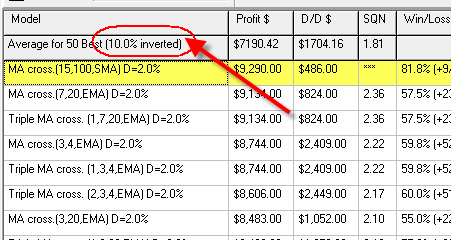
There only 5 from 50 strategies based on moving averages are inverted (it is 10% of 50); i.e. in most of the cases (90%) the classical moving averages crossover worked since 1900 till 1910. In other words, one hundred years ago the trend following strategy prevailed in the Stock Market Land. The weather in this land was made by investors. The trader's goal then and there was to find the appropriate strategy to move in the flow of the trend.
The Paradise is lost
Let us return back to our time and see what has happened in stock market land during those one hundred years. I've examined moving averages crossovers strategies using now Dow Jones Industrial Index price history for the years 2000-2010. The result is impressive:
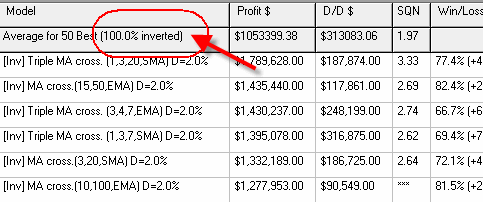
All 50 best trading strategies based on moving averages crossovers are inverted! This fact definitely tells us that the stock market now is moved by totally different gears than a hundred years ago. The most of the money in the stock market are made not from following the trend, they are made from the reversal movement. The weather on this land is made now by trading robots that are able to handle the smallest fluctuations of the price.
Inversion Index (II)
As a measure of the stock market status (i.e. trend following or return to average), I used Inversion Index (II). It is calculated this way: the program finds the best moving averages crossovers for the analyzed financial instrument (i.e. moving averages crossovers that provide the best profit; and we analyze both classical and inverted moving averages crossovers). The program analyzes more than a thousand of different moving averages crossover combinations. Among all those moving averages strategies, the program chooses 50 the best ones and calculates the percentage of inverted crossovers. The higher percentage of the inverted strategies amount indicates that, for the chosen financial instrument, return to average strategy works better than a trend following strategy.
For example, this record ![]() means that within the analyzed period two strategies are profitable:
#1 - the inverted simple moving averages crossover with periods fast=3 bars and
slow=20 bars, and #2 - the inverted triple moving averages crossover fast=3 bars
middle=5 bars slow=7 bars.
means that within the analyzed period two strategies are profitable:
#1 - the inverted simple moving averages crossover with periods fast=3 bars and
slow=20 bars, and #2 - the inverted triple moving averages crossover fast=3 bars
middle=5 bars slow=7 bars.
This index changes in 0%-100% diapason. If II index is high, it means that for the market in question there are more return to averages movements, while a low value of this index indicates that the trend following tendency is prevailing.
The advantage of this indicator is: it is very sensitive to the changes in the stock market behavior. It allows to see much more nuances than the standard R/S analysis.
History of Inversion Index
Let's look how this index has changed in time. I have downloaded the DJI price history data since the year 1890 and examined moving strategies on different 10 years intervals: 1890-1900, 1895-1905, 1900-1910 etc. For each interval, the Inversion Index is calculated. Here it is:
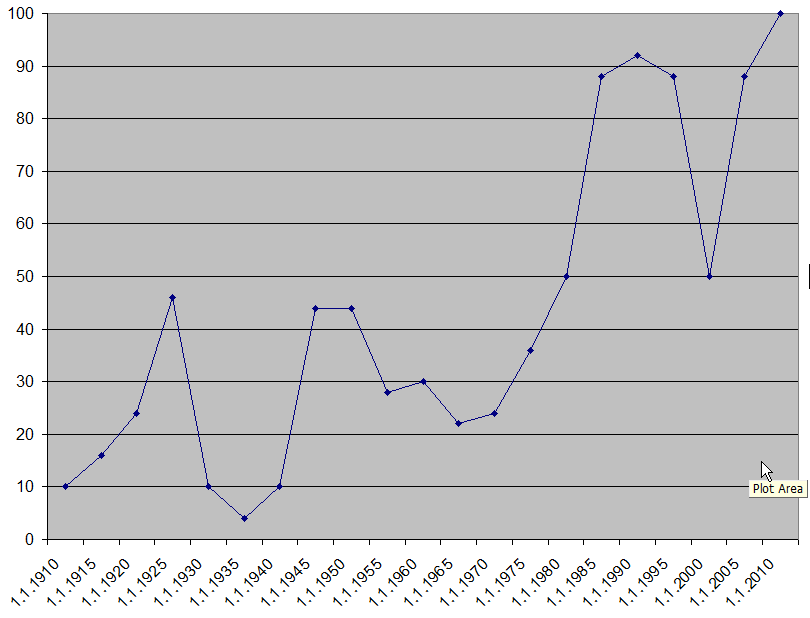
As you see, the inversion index was always less than 50% till 1980. Since 1985 it jumps to 89% and since that it is very high (the 50% drop in the year 2000 is caused by the big up trend in 1990s).
Now the question arises: when exactly and why this "return to averages" strategies have happened? I have calculated a more detailed diagram for this index covering 1975-1990 years:
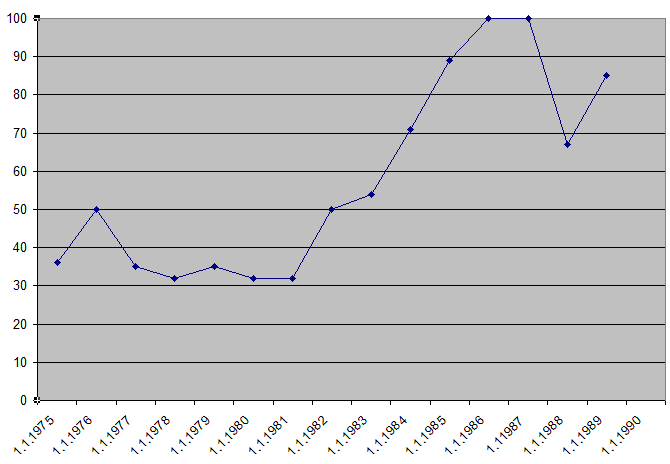
You can see here that these changes have happened starting from the year 1981.
Why? I do not know exactly. However, the first idea that comes to my mind while thinking about the year 1981 is Reagan's reforms, especially the deregulation of the financial sector (summer 1981). The new big player came to the stock market, automated trading systems started to be developed, and this fact totally changed the landscape of the stock market land. Inversion Index has pointed this change very precisely, up to a year.
Here you can download the Excel worksheet with these tables.
Toronto, Canada
July 10, 2010